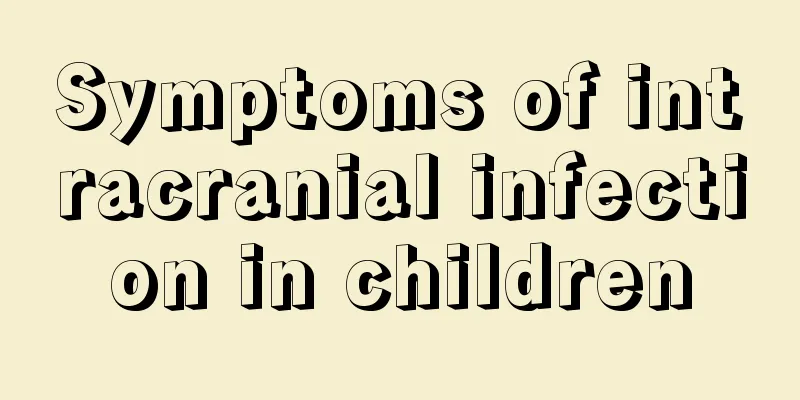Symptoms of intracranial infection in children

|
Intracranial infection is a common brain lesion in children. This lesion can cause various brain diseases, such as encephalitis and meningitis. The pathogens of intracranial infection may be bacteria and viruses, as well as parasites, fungi, etc. Since it is a relatively serious infection, it must be treated promptly to prevent the condition from getting worse. Below, we will introduce you to the specific knowledge about intracranial infection in children.
The main intracranial infections include meningitis, encephalitis, brain abscess, etc. Pathogens may be bacteria, viruses, parasites, mycoplasma, chlamydia, fungi, rickettsia, etc. In some domestic studies, intracranial infection has been listed as one of the four major hospital infections (lung, urinary system, deep trauma incision, and intracranial). Pathogens mainly come from one's own flora, but can also come from the external environment, including surrounding patients or medical staff. Intracranial infections in the field of neurosurgery are mostly caused by trauma and surgery; hematogenous abscesses, parasitic diseases, granulomas, and tuberculosis are also common. 2. Diagnosis 1. Ask about the time of injury, the type of object that caused the injury, whether there is leakage of cerebrospinal fluid or brain tissue from the wound, and what treatment has been performed. 2. Examination of head wounds: Check the size and shape of the wound, whether there is active bleeding, bone fragments, brain tissue or cerebrospinal fluid outflow. 3. Impairment of consciousness: Patients with limited open injuries that do not damage important brain structures or do not have intracranial hypertension usually have no disturbance of consciousness; however, patients with extensive brain damage, brainstem or hypothalamic injuries, combined with intracranial hematoma or cerebral edema causing intracranial hypertension may have varying degrees of disturbance of consciousness. 4. Focal symptoms depend on the location of brain damage, and may include hemiplegia, aphasia, epilepsy, homonymous hemianopsia, sensory impairment, etc.5. Symptoms of intracranial hypertension: Patients with severe intracranial pressure increase caused by small wounds, hematoma within the wound, or (and) combined intracranial hematoma and extensive cerebral contusion and laceration may experience headache, vomiting, progressive disturbance of consciousness, and even brain herniation. 6. Skull X-ray to understand the location, type, displacement of skull fracture, location of metal foreign bodies or embedded objects in the skull, etc. 7. CT scan of the head can also diagnose intracranial hematoma, cerebral contusion, subarachnoid hemorrhage, midline shift, ventricular size and shape, intracranial foreign bodies and skull fractures, but it is not as complete as plain X-rays. 8. Lumbar puncture is helpful in understanding whether there is intracranial infection and intracranial pressure. 9. Electroencephalogram is helpful in diagnosing traumatic epilepsy.
In the past, conventional treatment for intracranial infectious diseases was to use large doses of parenteral antibiotics, but the treatment effect was often less than ideal due to the following factors: (1) The existence of the blood-brain barrier prevents effective antibacterial concentrations from being reached in the cerebrospinal fluid; (2) The pathogens of intracranial infection are resistant to most antibiotics; (3) The infected cerebrospinal fluid lacks bactericidal activity and requires bactericidal rather than bacteriostatic drugs; (4) The high cost of treatment often causes some patients to discontinue treatment. Intrathecal injection has gradually become popular in clinical practice due to its simple operation and proven efficacy. Drugs and dosages that can be used for intrathecal injection (for reference only, to be supplemented) Chemotherapy drugs such as dexamethasone, domestic amphotericin B, fluconazole, isoniazid, laxative, ceftriaxone, vancomycin, methotrexate, cytarabine and cyclocytidine |
<<: Symptoms of pyloric stenosis in babies
>>: What tests are needed for night terrors
Recommend
What temperature is considered a fever in children?
For us adults, our normal body temperature is 37 ...
What to do if your baby gets diarrhea after eating dragon fruit
The baby is still so young, and there are many fo...
Relative treatment methods for red corners of baby's mouth
Nowadays, families are only allowed to have one c...
Children are always constipated, parents should do these
Constipation is caused by slow gastrointestinal m...
What exercises are good for children to grow taller?
Now that living standards have improved, the aver...
What to do if the newborn has enlarged ventricles
After a newborn is born, parents, in addition to ...
Is it normal for a girl to have vaginal discharge?
Some baby girls often cry incessantly, and their ...
Is bronchial asthma serious in children?
Recently, many children have developed bronchial ...
What should I do if my child has a stuffy nose? These methods are very useful
If a child has a stuffy nose, it may be that he h...
What is the normal vision of an eight-year-old child?
If we find that an eight-year-old child has poor ...
How to treat cough caused by viral cold in children?
Children are a group that is very prone to catchi...
When is the best age for circumcision of children?
When a little boy is born, his penis is completel...
How to treat hypertension in children?
Many children have problems that seriously threat...
What's going on when a child has a fever and complains of a headache?
A child's fever means that the child's bo...
What to do if your baby gets prickly heat?
In the hot summer, the human body sweats a lot, a...









